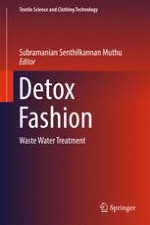2018 | OriginalPaper | Buchkapitel
Review of Utilization Plant-Based Coagulants as Alternatives to Textile Wastewater Treatment
verfasst von : Thabata Karoliny Formicoli Souza Freitas, Cibele Andrade Almeida, Daniele Domingos Manholer, Henrique Cesar Lopes Geraldino, Maísa Tatiane Ferreira de Souza, Juliana Carla Garcia
Erschienen in: Detox Fashion
Verlag: Springer Singapore
Aktivieren Sie unsere intelligente Suche, um passende Fachinhalte oder Patente zu finden.
Wählen Sie Textabschnitte aus um mit Künstlicher Intelligenz passenden Patente zu finden. powered by
Markieren Sie Textabschnitte, um KI-gestützt weitere passende Inhalte zu finden. powered by
